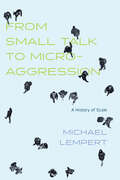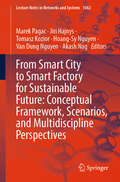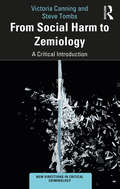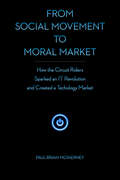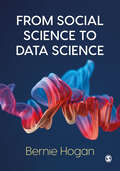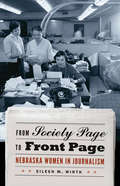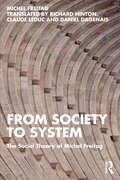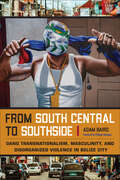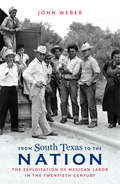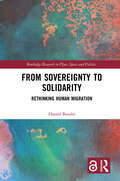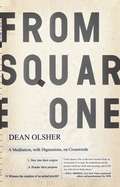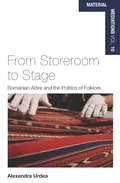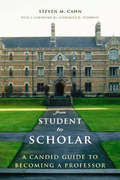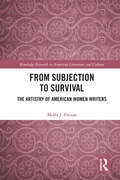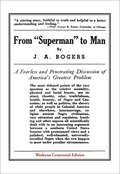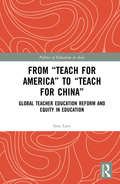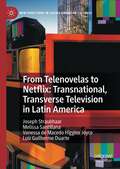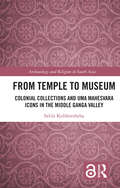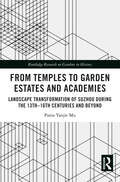- Table View
- List View
From Small Talk to Microaggression: A History of Scale
by Michael LempertA provocative and eye-opening history of how we have studied and theorized social interaction. In this ambitious, wide-ranging book, anthropologist Michael Lempert offers a conceptual history that explores how, why, and with what effects we have come to think of interactions as “scaled.” Focusing on the sciences of interaction in midcentury America, Lempert traces how they harnessed diverse tools and media technologies, from dictation machines to 16mm film, to study communication “microscopically.” In looking closely, many hoped to transform interaction: to improve efficiency, grow democracy, curb racism, and much else. Yet their descent into a microworld created troubles, with some critics charging that these scientists couldn’t see the proverbial forest for the trees. Exploring talk therapy and group dynamics studies, social psychology and management science, conversation analysis, “micropolitics,” and more, Lempert shows how scale became a defining problem across the behavioral sciences. Ultimately, he argues, if we learn how our objects of study have been scaled in advance, we can better understand how we think and interact with them—and with each other—across disciplinary and ideological divides. Even as once-fierce debates over micro and macro have largely subsided, Lempert shows how scale lives on and continues to affect the ethics and politics of language and communication today.
From Smart City to Smart Factory for Sustainable Future: Conceptual Framework, Scenarios, and Multidiscipline Perspectives (Lecture Notes in Networks and Systems #1062)
by Marek Pagac Jiri Hajnys Tomasz Kozior Hoang-Sy Nguyen Van Dung Nguyen Akash NagThis volume includes the proceedings of the 2nd International Conference on "From Smart City to Smart Factory for a Sustainable Future" (SCFF24), held at VSB - Technical University of Ostrava from May 14 to 16, 2024. The conference was organized in collaboration with university and institute partners from Czech Republic, Poland, India, and Vietnam. SCFF24 covers a broad range of topics, with a particular focus on the application of technologies in Smart Cities and Smart Factories to achieve a Sustainable Future. The Conference aims to bring together participants from diverse fields to share their knowledge, innovative ideas, and solutions to current challenges that hinder progress toward a more modern and sustainable life that we all share. In light on this, it also serves as a platform for the mutual exchange of experiences and the formation of enduring international collaborations. This book offers a comprehensive and multi-perspective view, providing readers with insights into the latest technological possibilities from voices around the world, with the hope of raising awareness and fostering further advancements in these fields.
From Social Harm to Zemiology: A Critical Introduction (New Directions in Critical Criminology)
by Victoria Canning Steve TombsThis book outlines key developments in understanding social harm by setting out its historical foundations and the discussions which have proliferated since. It examines various attempts to conceptualise social harm and highlights key sites of contestation in its relationship to criminology to argue that these act as the basis for an activist zemiology, one directed towards social change for social justice. The past two decades have seen a proliferation of debate related to social harm in and around criminology. From climate catastrophe and a focus on environmental harms, unprecedented deaths generating focus on border harms and the coronavirus pandemic revealing the horror of mass and arguably avoidable deaths across the globe, critical studies in social harm appear ever more pressing. Drawing on a range of international case studies of cultural, emotional, physical and economic harms, From Social Harm to Zemiology locates the study of social harm in an accessible fashion. In doing so it sets out how a zemiological lens can moves us beyond many of the problematic legacies of criminology. This book rejects criminologies which have disproportionately served to regulate intersectional groups, and which have arguably inflicted as much or more harm by bolstering the very ideologies of control in offering minor reforms that inadvertently expand and strengthen states and corporations. It does this by sketching out the contours, objects, methods and ontologies of a disciplinary framework which rejects commonplace assumptions of ‘value freedom’. From Social Harm to Zemiology advocates social change in accordance with groups who are most disenfranchised, and thus often most socially harmed. An accessible and compelling read, this book is essential reading for all zemiologists, critical criminologists, and those engaged with criminological and social theory.
From Social Movement to Moral Market: How the Circuit Riders Sparked an IT Revolution and Created A Technology Market
by Paul-Brian McinerneyIn From Social Movement to Moral Market, Paul-Brian McInerney explores what happens when a movement of activists gives way to a market for entrepreneurs. This book explains the transition by tracing the brief and colorful history of the Circuit Riders, a group of activists who sought to lead nonprofits across the digital divide. In a single decade, this movement spawned a market for technology assistance providers, dedicated to serving nonprofit organizations. In contrast to the Circuit Riders' grassroots approach, which was rooted in their commitment to a cause, these consultancies sprung up as social enterprises, blending the values of the nonprofit sector with the economic principles of for-profit businesses. Through a historical-institutional analysis, this narrative shows how the values of a movement remain intact even as entrepreneurs displace activists. While the Circuit Riders serve as a rich core example in the book, McInerney's findings speak to similar processes in other "moral markets," such as organic food, exploring how the evolution from movement to market impacts activists and enterprises alike.
From Social Science to Data Science: Key Data Collection and Analysis Skills in Python
by Bernie HoganFrom Social Science to Data Science is a fundamental guide to scaling up and advancing your programming skills in Python. From beginning to end, this book will enable you to understand merging, accessing, cleaning and interpreting data whilst gaining a deeper understanding of computational techniques and seeing the bigger picture. With key features such as tables, figures, step-by-step instruction and explanations giving a wider context, Hogan presents a clear and concise analysis of key data collection and skills in Python.
From Social Science to Data Science: Key Data Collection and Analysis Skills in Python
by Bernie HoganFrom Social Science to Data Science is a fundamental guide to scaling up and advancing your programming skills in Python. From beginning to end, this book will enable you to understand merging, accessing, cleaning and interpreting data whilst gaining a deeper understanding of computational techniques and seeing the bigger picture. With key features such as tables, figures, step-by-step instruction and explanations giving a wider context, Hogan presents a clear and concise analysis of key data collection and skills in Python.
From Society Page to Front Page: Nebraska Women in Journalism
by Eileen WirthEileen M. Wirth never set out to be a groundbreaker for women in journalism, but if she wanted to report on social issues instead of society news, she had no alternative. Her years as one of the first women reporters at the Omaha World-Herald, covering gender barriers even as she broke a few herself, give Wirth an especially apt perspective on the women profiled in this book: those Nebraskans who, over a hundred years, challenged traditional feminine roles in journalism and subtly but surely changed the world.The book features remarkable women journalists who worked in every venue, from rural weeklies to TV. They fought for the vote, better working conditions for immigrants, and food safety at the turn of the century. They covered wars from the Russian Revolution to Vietnam. They were White House reporters and minority journalists who crusaded for civil rights. Though Willa Cather may be the only household name among them, all are memorable, their stories affording a firsthand look into the history of journalism and social change.
From Society to System: The Social Theory of Michel Freitag
by Michel FreitagFrom Society to System presents sociologist Michel Freitag’s (1935-2009) distinctive, multifaceted and interdisciplinary work. Elaborated within the grand sociological tradition, his dialectical sociology redefines sociality as the realm of the symbolic to pinpoint its ontological frailty. Such a perspective expands the borders within sociology to rejoin classical philosophical preoccupations, revisiting social ontology as a radical critique of contemporary society where not only life and planet earth is at stake as a result of capitalism but reflexivity as well. This collection of essays touches on topics that have been of central concern for social theory since the end of the 20th century: the discussion about holism versus individualism and the dissolution of transcendental identity; the current state of the social sciences, both epistemologically and practically; the end-of-20th century debate over the nature of society along with its future in the context of globalisation. These essays show how Freitag’s sociology is part of a larger unified framework that integrates ontology, epistemology, anthropology and philosophy into a coherent vision of the world – testifying to the distinctiveness of Freitag’s social theory, standing next to other great social theorists such as Margaret Archer, Jürgen Habermas, Murray Bookchin and Ulrich Beck.
From Sofia to Jaffa: The Jews of Bulgaria and Israel (Raphael Patai Series in Jewish Folklore and Anthropology)
by Raphael Patai Guy H. HaskellWithin two years of the establishment of the State of Israel in 1948, an astounding 45,000 of Bulgaria's 50,000 Jews left voluntarily for Israel. This mass exodus was remarkable considering that Bulgaria was the only Axis power to prevent the deportation of its Jews to the death camps during World War II. After their arrival in Israel, the Jews of Bulgaria were recognized as a model immigrant group in a fledgling state attempting to absorb hundreds of thousands of newcomers from more than eighty countries. They became known for their independence, self-reliance, honesty, and hard work. <P><P> From Sofia to Jaffa chronicles the fascinating saga of a population relocated, a story that has not been told until now. Beginning with a study of the community in Bulgaria and the factors that motivated them to leave their homeland, this book documents the journey of the Bulgarian Jews to Israel and their adaptation to life there.
From South Central to Southside: Gang Transnationalism, Masculinity, and Disorganized Violence in Belize City (Studies in Transgression)
by Adam BairdWhen he visited in 2011, sociologist Adam Baird wondered what the Bloods and Crips were doing in Southside Belize City. He soon discovered that migrant Belizean members of colors gangs from South Central Los Angeles were deported there in the 1980s. Once established “back home,” membership in the Bloods and Crips was seen as an aspirational pathway to manhood for the urban underclass. From South Central to Southside charts the genesis and evolution of a transnational gang culture. Baird provides firsthand interviews with gang members and “narco” families and explains the surprising source of Belize City’s severe violence and skyrocketing homicide rates. He identifies gang violence in the U.S. and Belize as stemming from populations blighted by historical, brutal inequality and marginalization. Analyzing the gendered dynamics as young men and women face the temptations, risks, and dangers of gang life, Baird shines a light on “chronic vulnerability" in Belize City.
From South Texas to the Nation: The Exploitation of Mexican Labor in the Twentieth Century (The David J. Weber Series in the New Borderlands History)
by John WeberIn the early years of the twentieth century, newcomer farmers and migrant Mexicans forged a new world in South Texas. In just a decade, this vast region, previously considered too isolated and desolate for large-scale agriculture, became one of the United States' most lucrative farming regions and one of its worst places to work. By encouraging mass migration from Mexico, paying low wages, selectively enforcing immigration restrictions, toppling older political arrangements, and periodically immobilizing the workforce, growers created a system of labor controls unique in its levels of exploitation.Ethnic Mexican residents of South Texas fought back by organizing and by leaving, migrating to destinations around the United States where employers eagerly hired them--and continued to exploit them. In From South Texas to the Nation, John Weber reinterprets the United States' record on human and labor rights. This important book illuminates the way in which South Texas pioneered the low-wage, insecure, migration-dependent labor system on which so many industries continue to depend.
From Sovereignty to Solidarity: Rethinking Human Migration (Space Power and Politics)
by Harald BauderFrom Sovereignty to Solidarity seeks to re-imagine human mobility in ways that are de-linked from national sovereignty. Using examples from around the world, the author examines contemporary practices of solidarity to illustrate what such a conceptualization of human mobility looks like. He suggests that urban and local scales, rather than the national scale, is a better way to frame human migration and belonging. The book ultimately proposes that solidarity, rather than sovereignty, offers an alternative approach to imagine how human mobility should, and already does, occur. This book will be relevant to upper-level undergraduate and graduate students in disciplines such as Migration Studies, Urban Studies, Human and Political Geography, and Refugee Studies. It is also relevant to researchers, development workers and human rights/environmental activists, and other intellectual practitioners.
From Square One
by Dean OlsherFrom Square One is Dean Olsher's captivating and in-depth exploration of the cultural history, psychology, and even metaphysics of crosswords -- their promise of a world without chaos and uncertainty. It is often repeated that more than 50 million Americans do crossword puzzles on a regular basis. Skeptical of that claim, Dean Olsher does his own research and finds that the number is nearly dead-on. Filled with lively, original reporting, From Square One disputes the widely held belief that solving crosswords helps prevent Alzheimer's; in fact, the drive to fill in empty spaces is more likely a mental illness than a cure. While "puzzle addiction" is usually meant as a lighthearted metaphor, the term contains more than a nugget of truth. Olsher looks into the origins and traditions of this popular pastime, which made its debut in a New York newspaper in 1913. Or did it? Along the way, he takes readers inside the making of a crossword. He also revives the quest of musical-theater legend and puzzle constructor Stephen Sondheim to find an American audience for a British crossword style that demands a love of verbal playfulness over knowledge of arcane trivia. Informative, engaging, and often surprising, From Square One is a unique and enjoyable read for puzzlers and nonpuzzlers alike.
From Steel to Slots: Casino Capitalism in the Postindustrial City
by Chloe E. TaftBethlehem PA was synonymous with steel. But after the factories closed, the city bet its future on casino gambling. Chloe Taft describes a city struggling to make sense of the ways global capitalism transforms jobs, landscapes, and identities. While residents often have few cards to play, the shape economic progress takes is not inevitable.
From Storeroom to Stage: Romanian Attire and the Politics of Folklore (Material Mediations: People and Things in a World of Movement #10)
by Alexandra UrdeaDeparting from an ethnographic collection in London, From Storeroom to Stage traces the journey of its artefacts back to the Romanian villages where they were made 70 years ago, and to other places where similar objects are still in use. The book explores the role that material culture plays in the production of value and meaning by examining how folk objects are mobilized in national ideologies, transmissions of personal and family memory, museological discourses, and artistic acts.
From Student to Scholar
by Steven M. Cahn Catharine R. StimpsonSteven M. Cahn's advice on the professorial life covers an extensive range of critical issues: how to plan, complete, and defend a dissertation; how to navigate a job interview; how to improve teaching performance; how to prepare and publish research; how to develop a professional network; and how to garner support for tenure. He deals with such hurdles as a difficult dissertation advisor, problematic colleagues, and the pressures of the tenure clock. Whether you are beginning graduate study, hoping to secure an academic position, or striving to build a professorial career, Cahn's insights are invaluable to traversing the thickets of academia.
From Subjection to Survival: The Artistry of American Women Writers (Routledge Research in American Literature and Culture)
by Molly J. FreitasFrom Subjection to Survival is a work of feminist scholarship that works at the intersection of literature and art history, the written and the visual. By examining six important and diverse multiethnic American women writers of the twentieth century (Kate Chopin, Anzia Yezierska, Edith Wharton, Zitkala-Ša, Nella Larsen, and Helena María Viramontes), From Subjection to Survival establishes a genealogy of how women writers claim the power and possibility of visual art to make sense of their experiences. These writers write about women and feature female protagonists who engage with art as painters, writers, muses, or icons in the texts themselves. The texts are written visually to expose the fundamental substantiation of gender in art and the unavoidable aestheticization of women in daily life. As every text in this book makes clear, women can claim substantial power through art. Yet, aestheticization is not always positive. As a consequence of such negative possibilities, the artistic self-referentiality of all of the texts in From Subjection to Survival exposes a negotiated course between subjectivity and objectness which women experience when engaging with art. From Subjection to Survival studies this negotiated course to lay bare the difficult path of women’s artistic and aesthetic experience, but ultimately to claim the power and the possibility of the visual arts for women.
From Suburb to Shtetl: The Jews of Boro Park
by Egon Mayer William B. Helmreich"From Suburb to Shtetl" is an outstanding ethnography that moves beyond simple demographics. Mayer weaves an intricate tapestry of how family, school, and community leaders influence each other. Whether discussing the role of the rebbe or the matchmaker, those who know these communities will find what he says as relevant today as it was when first penned. This is hardly surprising, for the ultra-Orthodox community takes great pride in not changing, in maintaining itself as it was in Europe despite the allure of modern American society. His discussion of synagogue life is particularly informative and evocative. Those in charge of helping immigrants adopted the path of least resistance, allowing and even encouraging them to retain their identities except for those few aspects that might threaten the country's national interests. The American Orthodox community was tremendously augmented by the arrival from Europe, after World War Two, of thousands of Orthodox Jews who remained devoted to that way of life. Egon Mayer was himself part of a smaller, but significant group of Jews who came to the U.S. and settled mostly in Boro Park in the wake of the 1956 Hungarian Revolution. The interaction between the Hasidim and their less fervent Orthodox counterparts described and analyzed in this volume tells us a great deal about how people negotiate their beliefs, values, and norms when forced into close contact with each other in an urban setting within the larger American culture. By exploring these and many other related issues Mayer has given us the chance to assess and forecast the future of American Jewish life as a whole.
From “Superman” to Man: A Fearless and Penetrating Discussion of America's Greatest Problem
by J. A. RogersJoel Augustus Roger's seminal work, this novel first published in 1917 is a polemic against the ignorance that fuels racism. The central plot revolves around a debate between a Pullman porter and a white racist Southern politician.
From Synagogue to Church: Its Beginning, its Definition, its End (Routledge Jewish Studies Series)
by John WilkinsonThe designs of synagogues and churches are acknowledged to be very alike. But the designers' procedure was confidential, and so far standard explanations have been unsatisfactory. A synagogue should express heavenly values with earthly materials. This combination was in fact expressed in numbers, for, as Plato said, they linked heaven and earth. Scripture described both the Jewish Tabernacle and Temple with a wealth of numbers. Proportions based on these numbers were used to design synagogues. Only a few Jewish documents survive, but they reveal a symbolism, which Christians sometimes repeat. The synagogue sanctuary was designed to contain the 'Holy Ark', and the mosaic floors reveal the point 'Before the Ark' for the prayers and readings. These places faced each other, with the idea that God was facing his people. The synagogue was seen as facing heaven and in church buildings Christians repeated the same proportions. This was a joint tradition among Jews and Christians. It was easy to design, was carried out secretly and accurately, and - without a computer - was extremely hard to unravel. This book, for the first time, does just that.
From “Teach For America” to “Teach For China”: Global Teacher Education Reform and Equity in Education (Politics of Education in Asia)
by Sara LamThis book examines the role of Teach For China in addressing educational equity and expanding public participation in education. The author uses the case of Teach For China to explore the broader theme of the mobility of education models between contexts characterized by neoliberalism and those characterized by strong state control. Transnational advocacy networks are increasingly influential in the education policy making process. These networks, comprised of entrepreneurs and education corporations, think tanks, philanthropists, and government agencies, facilitate the global mobility of policy models. It is widely accepted that an education model should not be transplanted from one context to another without careful consideration of how contextual differences might impact the model’s effectiveness. The book explores the argument that the same model is not only quantitatively different in terms of effectiveness, but that models can play qualitatively different roles in neoliberal and strong-state contexts, sometimes moving education reform in opposite directions. The book will appeal to anyone interested in global teacher education reform and equity in education.
From Telecommunications Liberalization to Net Neutrality Rules: A Longitudinal Institutional Analysis of EU Communications Policy (Studien der NRW School of Governance)
by Simon P. RinasEU communications policy has massively changed due to both global competition on the ICT market and technological developments that led to the emergence of Internet technology. This book analyzes the structural and procedural transformation processes inside the EU legislative processes and concludes that EU communications policy struggles to reflect today's internet-enabled communications reality. It provides insights in the institutional conditions that maintained specific patterns of EU communications policy since the beginning of telecommunications regulation and concludes with an outlook on the technological and regulatory challenges ahead.
From Telenovelas to Netflix: Transnational, Transverse Television in Latin America (New Directions in Latino American Cultures)
by Joseph Straubhaar Melissa Santillana Vanessa de Macedo Higgins Joyce Luiz Guilherme DuarteThis book is about television in Latin America. Its national and regional industries create most television programming there within genres developed over time in the region. However, part of the programming has always come from the U.S., Europe and elsewhere. With cable, satellite and now streaming TV, that inflow of foreign programming has increased substantially. While many in the audience still prefer national or regional programs for their cultural proximity, an increasing number among the upper-middle and middle classes, particularly the young, are turning to the new foreign services, like Netflix, Amazon and Disney for class distinction, cosmopolitanism or other motives. Among the television industries, global, regional and national actors are creating a variety of programs and channels (broadcast, pay-TV and streaming) to segment and appeal to different parts of the audience.
From Temple to Museum: Colonial Collections and Umā Maheśvara Icons in the Middle Ganga Valley (Archaeology and Religion in South Asia)
by Salila KulshreshthaReligious icons have been a contested terrain across the world. Their implications and understanding travel further than the artistic or the aesthetic and inform contemporary preoccupations.This book traces the lives of religious sculptures beyond the moment of their creation. It lays bare their purpose and evolution by contextualising them in their original architectural or ritual setting while also following their displacement. The work examines how these images may have moved during different spates of temple renovation and acquired new identities by being relocated either within sacred precincts or in private collections and museums, art markets or even desecrated and lost.The book highlights contentious issues in Indian archaeology such as renegotiating identities of religious images, reuse and sharing of sacred space by adherents of different faiths, rebuilding of temples and consequent reinvention of these sites. The author also engages with postcolonial debates surrounding history writing and knowledge creation in British India and how colonial archaeology, archival practices, official surveys and institutionalisation of museums has influenced the current understanding of religion, sacred space and religious icons. In doing so it bridges the historiographical divide between the ancient and the modern as well as socio-religious practices and their institutional memory and preservation. Drawn from a wide-ranging and interdisciplinary study of religious sculptures, classical texts, colonial archival records, British travelogues, official correspondences and fieldwork, the book will interest scholars and researchers of history, archaeology, religion, art history, museums studies, South Asian studies and Buddhist studies.
From Temples to Garden Estates and Academies: Landscape Transformation of Suzhou During the 13th–16th Centuries and Beyond (Routledge Research on Gardens in History)
by Pania Yanjie MuHow did the temple-scape of Suzhou transform into garden-scape during the 13th to 16th centuries? This book investigates the landscape evolution of China during the Yuan-Ming socio-political transformation and provides a previously unrepresented Buddhist and hydraulic history of Chinese gardens.Utilising historical GIS mapping and 3D architectural modelling, the research uncovers spatial strategies employed by monks, the gentry, and the government. It argues that by seizing hydraulic estates from Buddhists, the gentry and government rose as a landed class and cultural elites, establishing the literati garden. Yuan temples featured a mound-field-river topography which reclaimed urban wetlands. In temples such as Shizi Lin, scenes were crafted as Chan gong’ans to support Buddhist practice towards enlightenment, underpinning a monastic architectural transformation in the 14th century. In the Ming dynasty, the gentry and government exploited the hydro-topography while erasing Buddhist traces by converting temples into gardens. The book forms a theoretical model of triangulating the garden practice with socio-hydro spaces and advocates a new garden history enabled by historical mapping and modelling.This book is aimed at students and scholars of East Asian history, temples and gardens, and landscape architecture and design.
